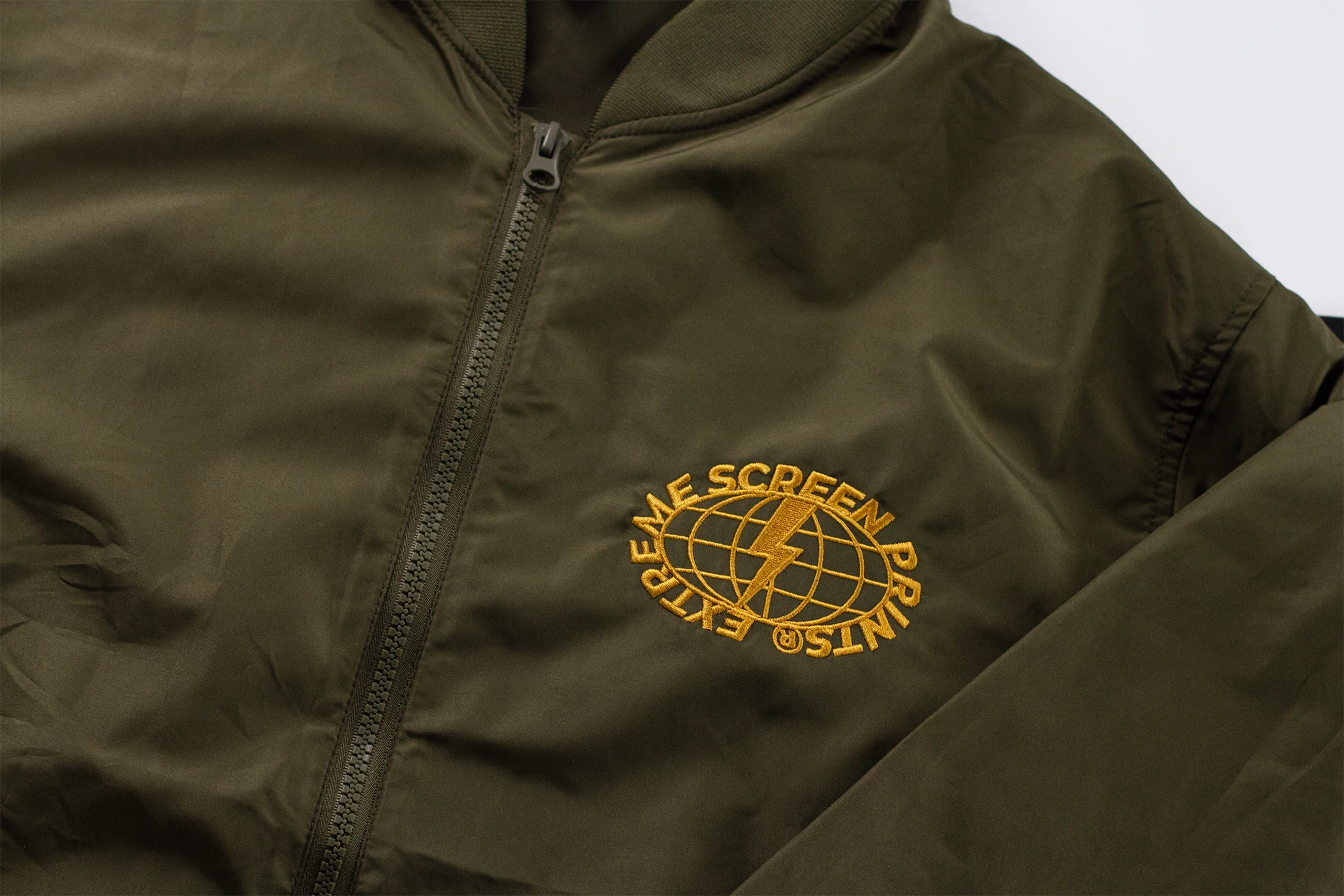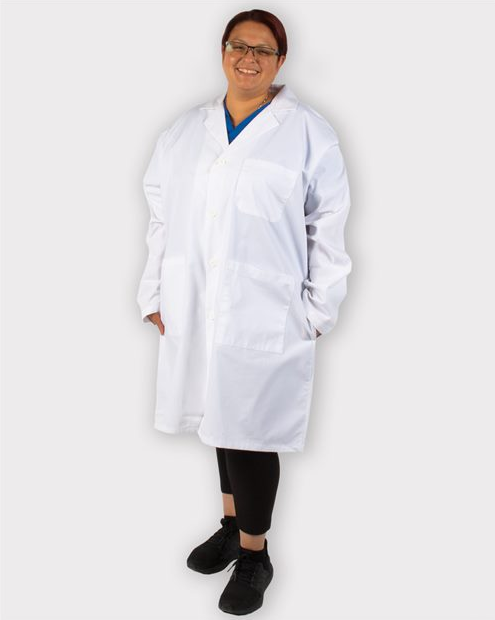

Industrial workwear demands exceptional durability, safety compliance, and professional appearance. Workwear embroidery has emerged as the premier solution for creating custom uniforms that withstand harsh industrial environments while maintaining brand identity and safety standards. This comprehensive technical specification guide addresses the critical requirements for safety managers, industrial buyers, and workwear suppliers seeking reliable embroidered uniform solutions.
Extreme Screen Prints specializes in heavy-duty workwear embroidery explicitly designed for industrial applications. With advanced digitization techniques, industrial-grade thread selection, and rigorous quality control processes, we deliver embroidered uniforms that meet the demanding requirements of manufacturing, construction, oil and gas, and other industrial sectors.

Industrial workwear embroidery operates under fundamentally different parameters than standard decorative embroidery. The primary distinction lies in durability requirements, safety compliance, and environmental resistance. Standard embroidery typically uses 40-weight polyester thread with 4,000-6,000 stitches per square inch, while industrial applications require 30-weight or heavier threads with optimized stitch densities of 3,000-4,500 stitches per square inch to prevent thread breakage under stress.
Thread selection becomes critical in industrial applications. Polyester threads offer superior chemical resistance and UV stability, which are essential for outdoor industrial applications. Rayon threads, while providing excellent sheen, lack the durability required for heavy-duty applications. Specialized aramid fiber threads provide flame resistance for welding and high-temperature environments, though they require modified digitization techniques due to their unique handling characteristics.
Reinforcement techniques distinguish industrial embroidery from standard applications. Double-layer backing, edge sealing, and strategic underlay patterns prevent design degradation under mechanical stress. Pull-strength testing demonstrates that properly reinforced industrial embroidery withstands 150-200% more stress than standard techniques before failure occurs.
Thread selection forms the foundation of durable workwear embroidery. Industrial-grade polyester threads, specifically 30-weight and 40-weight variants, provide optimal balance between durability and appearance. These threads undergo specialized treatments, including mercerization for strength enhancement and silicone coating for reduced friction during high-speed embroidery production.
Thread Performance Specifications:
Specialized thread types serve specific industrial requirements. Flame-retardant threads meet NFPA 2112 standards for flash fire protection. Conductive threads provide static dissipation in electronics manufacturing environments. High-visibility threads retain their retroreflective properties after 100+ industrial wash cycles, a crucial requirement for safety compliance in the transportation and construction sectors.
Thread color selection impacts both aesthetics and functionality. Dark colors (navy, black, forest green) demonstrate superior soil hiding and maintain a professional appearance longer. High-contrast combinations enhance visibility and brand recognition. Fluorescent threads require UV-stable formulations to prevent rapid color degradation in outdoor applications.
Reinforcement engineering transforms standard embroidery into industrial-grade decoration that can withstand extreme conditions. Multi-layer backing systems distribute stress across larger fabric areas, preventing localized failure points. Primary backing utilizes a 2.5-ounce cutaway stabilizer, while secondary backing employs a 1.5-ounce tearaway for dimensional stability during production.
Reinforcement Layer Specifications:
Underlay pattern engineering provides a structural foundation for surface embroidery. Center-run underlay creates directional stability for text elements. Edge-run underlay defines design boundaries and prevents fabric show-through. Zigzag underlay offers maximum coverage for solid fill areas while maintaining flexibility. Proper underlay reduces surface thread consumption by 15-20% while improving durability.
Stitch density optimization strikes a balance between coverage and flexibility. Excessive density creates rigid areas prone to cracking, while insufficient density allows fabric to show through and reduces durability. Optimal density ranges from 3,000 to 4,500 stitches per square inch, adjusted based on fabric weight and the intended application. Gradient density techniques transition from high-density centers to lower-density edges, reducing stress concentration.
Industrial workwear embroidery must comply with multiple safety standards depending on the application sector. ANSI/ISEA 107 governs high-visibility safety apparel, specifying the placement of retroreflective tape and the requirements for background fabric. Embroidered elements cannot interfere with required retroreflective areas or compromise garment safety ratings.
Key Safety Standard Requirements:
NFPA 2112 compliance requires flame-resistant thread materials and specific construction techniques. Embroidered areas must maintain the fabric's flame-resistant properties without creating ignition points or melting hazards. Thread selection becomes critical, as standard polyester threads can melt and cause severe burns. Aramid fiber threads or specially treated flame-resistant polyester threads meet these requirements.
Arc-rated garments, as defined by ASTM F1506, present unique challenges for embroidered decoration. Embroidery can create potential failure points in arc-protective fabrics. Specialized testing protocols evaluate embroidered samples for arc thermal performance value (ATPV) maintenance. Proper thread selection and minimal design coverage preserve garment protection ratings.
Documentation requirements include material certificates, testing reports, and compliance declarations. Each embroidered garment lot requires traceability documentation linking thread specifications, production parameters, and quality control results. This documentation supports safety audits and verifies regulatory compliance.
Industrial laundering subjects workwear to extreme conditions far exceeding home washing parameters. Commercial washing temperatures range from 160 to 180°F, utilizing aggressive detergents, bleaching agents, and mechanical action. Embroidered elements must withstand these conditions while maintaining appearance and structural integrity throughout 100+ wash cycles.
Industrial Washing Test Parameters:
Durability testing protocols evaluate embroidery performance under accelerated aging conditions. AATCC Test Method 61 measures colorfastness to laundering, while ASTM D3884 evaluates abrasion resistance. Custom testing protocols simulate specific industrial conditions, including chemical exposure, UV degradation, and mechanical stress.
Thread pre-treatment enhances washing durability. Silicone coating reduces friction and prevents thread breakage during aggressive washing cycles. Colorfast treatments avoid dye migration and maintain color integrity. Antibacterial treatments inhibit microbial growth in moisture-retentive areas, such as those with embroidered designs.
Quality control checkpoints throughout production ensure consistent durability performance. Thread tension monitoring prevents loose stitches that fail prematurely. Stitch density verification ensures adequate coverage without over-densification. The final inspection includes pull-testing at stress points and a visual examination for potential failure indicators.
Industrial workwear embroidery demonstrates significant cost advantages over alternative decoration methods and uniform replacement cycles. Initial embroidery costs range from $8 to $15 per garment, depending on the design complexity, while heat-applied graphics cost $3 to $8 but require replacement every 25 to 50 wash cycles. Screen printing offers lower initial costs ($2-5) but lacks durability for industrial applications.
Cost Comparison Analysis (Per Garment, 100-Wash Lifecycle):
Lifecycle cost analysis reveals embroidery's superior value proposition. Quality embroidered workwear maintains professional appearance for 18-24 months in industrial environments, while undecorated garments require replacement every 12-15 months due to staining and wear. This extended lifecycle reduces procurement costs, inventory management, and employee downtime for uniform distribution.
Productivity benefits include enhanced employee identification, improved safety compliance, and strengthened brand presence. Studies indicate a 23% improvement in safety incident reporting when employees wear uniforms with identified and embroidered safety messaging. Brand visibility increases customer confidence and supports marketing objectives in client-facing industrial environments.
Return on investment calculations demonstrate 40-60% cost savings over three-year periods. A 100-employee industrial facility investing $1,200 in embroidered uniforms saves $2,000 to $ 3,000 annually compared to replacement-based decoration methods. Additional savings include reduced administrative overhead, improved inventory management, and an enhanced professional image that supports business development.

Pre-Production Compliance Checklist:
Production Quality Control Checklist:
Post-Production Validation Checklist:
Quality assurance protocols ensure consistent performance across production runs. Statistical process control monitors key parameters including stitch density, thread tension, and color accuracy. Automated inspection systems detect defects before final processing, reducing rework costs and delivery delays.
Continuous improvement programs analyze field performance data to optimize future production. Customer feedback integration helps identify performance issues and drives updates to specifications. Regular equipment calibration maintains production consistency and prevents quality degradation over time.
What thread weight is recommended for heavy-duty industrial embroidery? 30-weight polyester thread provides optimal durability for most industrial applications. This heavier thread offers superior tensile strength and abrasion resistance compared to standard 40-weight threads. For extreme conditions, 20-weight threads may be specified, though they require modified digitization techniques and specialized equipment capabilities.
How does embroidery placement affect safety compliance? Embroidery placement must not interfere with required safety elements, including retroreflective tape, flame-resistant fabric properties, or arc-protection ratings. ANSI/ISEA 107 specifies minimum distances between decorative elements and safety features. Proper placement consultation ensures compliance while maintaining design effectiveness.
What backing materials offer the best durability for industrial washing? Cutaway backing provides superior durability for industrial washing conditions. 2.5-ounce cutaway stabilizer distributes stress and prevents design distortion during aggressive washing cycles. Tearaway backing, while suitable for lighter applications, may compromise durability in industrial environments.
How many wash cycles should industrial embroidery withstand? Quality industrial embroidery should maintain appearance and structural integrity for a minimum of 100 wash cycles under commercial laundering conditions. Premium applications may specify 150+ cycles. Proper thread selection, reinforcement techniques, and quality control ensure these durability targets are consistently achieved.
What factors affect embroidery cost for industrial applications? Design complexity, stitch count, thread specifications, and production volume primarily determine costs. Complex designs with multiple colors and high stitch counts increase production time and material costs. Specialized threads for flame resistance or chemical compatibility command premium pricing. Volume discounts apply for larger orders.
Can embroidery be applied to flame-resistant workwear? Yes, with proper thread selection and technique modifications. Aramid fiber threads or specially treated flame-resistant polyester threads maintain fabric safety ratings. Design coverage must be minimized to preserve fabric properties, and specialized testing verifies continued compliance with NFPA standards.
What documentation is required for safety-critical applications? Complete material traceability, including thread certificates, production parameters, quality control results, and compliance testing reports. Documentation must demonstrate adherence to applicable safety standards and provide an audit trail for regulatory compliance verification. Batch tracking enables rapid response to any quality issues.
Industrial workwear embroidery represents a strategic investment in employee safety, brand visibility, and operational efficiency. The technical specifications, compliance requirements, and quality assurance protocols outlined in this guide ensure your embroidered uniforms deliver maximum value throughout their service lifecycle.
Professional embroidery services provide the expertise, equipment, and quality systems necessary for successful industrial applications. Extreme Screen Prints combines advanced digitization capabilities with industrial-grade production systems to deliver workwear embroidery that meets the most demanding requirements.
Ready to enhance your industrial workwear program with durable, compliant embroidery solutions? Get an instant embroidery quote or call us at 616-202-1133 to discuss your specific requirements with our technical specialists. Our team provides comprehensive consultation services to ensure your embroidered workwear meets all safety, durability, and performance objectives while delivering exceptional value for your organization.